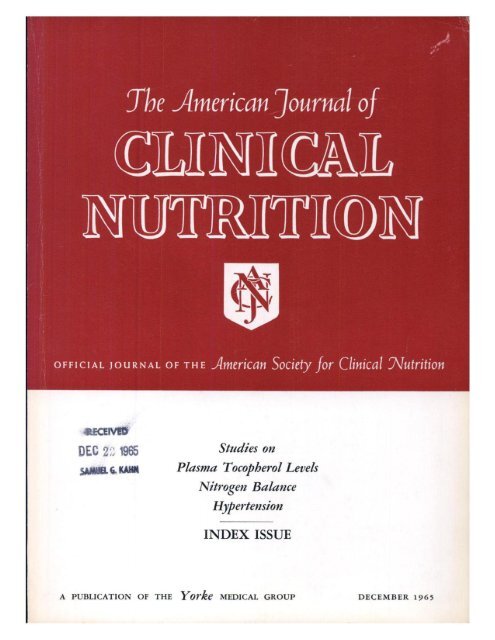Prediction models of basal energy expenditure in children and adolescents across the BMI spectrum based on room calorimetry: a cross-sectional cohort study
IF 6.5
1区 医学
Q1 NUTRITION & DIETETICS
引用次数: 0
Abstract
Background
Existing equations for prediction of basal energy expenditure (BEE) may not be accurate in children with overweight or obesity (OW/OB).
Objectives
We aimed to develop BEE prediction equations applicable to children and adolescents across a wide BMI spectrum using gold standard room calorimetry.
Methods
We measured weight, height, waist and hip circumferences, body composition (DXA), and BEE (whole room calorimetry) in a cross-sectional cohort of 1155 healthy children, 5–19 years of age. 67% of the males and 51% of the females were classified as OW/OB. We applied multiple linear regression analyses to develop BEE prediction models for each sex. Using relevant predictors, we developed models with fat-free mass (FFM); waist and hip circumference; weight and height only; and weight only. A representative sample of participants (83 males, 125 females) served as a validation dataset to test model performance. The models’ performance in predicting BEE was compared to existing models in the literature.
Results
Model fits (R2) for the new BEE prediction models were = 0.84 (P < 0.0001). Our BEE prediction models performed equally in children with normal weight and OW/OB, with <1.5% difference between the measured versus predicted BEE in the validation dataset for both sexes. In Bland-Altman analysis, our BEE prediction models were superior to existing prediction models, especially for children with higher BEEs.
Conclusions
New BEE prediction models developed and tested in cohorts representative of children with normal weight and OW/OB had superior performance compared with existing models. The BEE prediction equations based on simple anthropometrics or body composition provided improved accuracy and precision for children with NW or OW/OB, ages 5 to 19. More accurate estimates of BEE should allow for better estimates of energy requirements of children.
基于室内量热法的儿童和青少年BMI谱基础能量消耗预测模型:一项横断面队列研究
背景:现有的基础能量消耗(BEE)预测公式在超重或肥胖儿童(OW/OB)中可能不准确。我们的目的是利用金标准室内量热法建立适用于儿童和青少年广泛BMI谱的BEE预测方程。方法:我们测量了1155名5-19岁健康儿童的体重、身高、腰围和臀围、身体成分(DXA)和BEE(全室量热法)。67%的男性和51%的女性被归类为OW/OB。我们应用多元线性回归分析来建立不同性别的蜜蜂预测模型。利用相关的预测因子,我们建立了无脂质量(FFM)模型;腰臀围;仅限体重和身高;而且只有重量。参与者的代表性样本(83名男性,125名女性)作为验证数据集来测试模型的性能。将模型在预测BEE方面的表现与文献中的现有模型进行了比较。结果:新BEE预测模型的模型拟合(R2)为= 0.84 (p)。结论:新BEE预测模型在正常体重和OW/OB儿童中具有代表性的队列中开发和测试,与现有模型相比具有更好的性能。基于简单人体测量或身体成分的BEE预测方程为5至19岁的NW或OW/OB儿童提供了更高的准确性和精确性。更准确的BEE估计应该能够更好地估计儿童的能量需求。
本文章由计算机程序翻译,如有差异,请以英文原文为准。
求助全文
约1分钟内获得全文
求助全文
来源期刊
CiteScore
12.40
自引率
4.20%
发文量
332
审稿时长
38 days
期刊介绍:
American Journal of Clinical Nutrition is recognized as the most highly rated peer-reviewed, primary research journal in nutrition and dietetics.It focuses on publishing the latest research on various topics in nutrition, including but not limited to obesity, vitamins and minerals, nutrition and disease, and energy metabolism.
Purpose:
The purpose of AJCN is to:
Publish original research studies relevant to human and clinical nutrition.
Consider well-controlled clinical studies describing scientific mechanisms, efficacy, and safety of dietary interventions in the context of disease prevention or health benefits.
Encourage public health and epidemiologic studies relevant to human nutrition.
Promote innovative investigations of nutritional questions employing epigenetic, genomic, proteomic, and metabolomic approaches.
Include solicited editorials, book reviews, solicited or unsolicited review articles, invited controversy position papers, and letters to the Editor related to prior AJCN articles.
Peer Review Process:
All submitted material with scientific content undergoes peer review by the Editors or their designees before acceptance for publication.

 求助内容:
求助内容: 应助结果提醒方式:
应助结果提醒方式:


